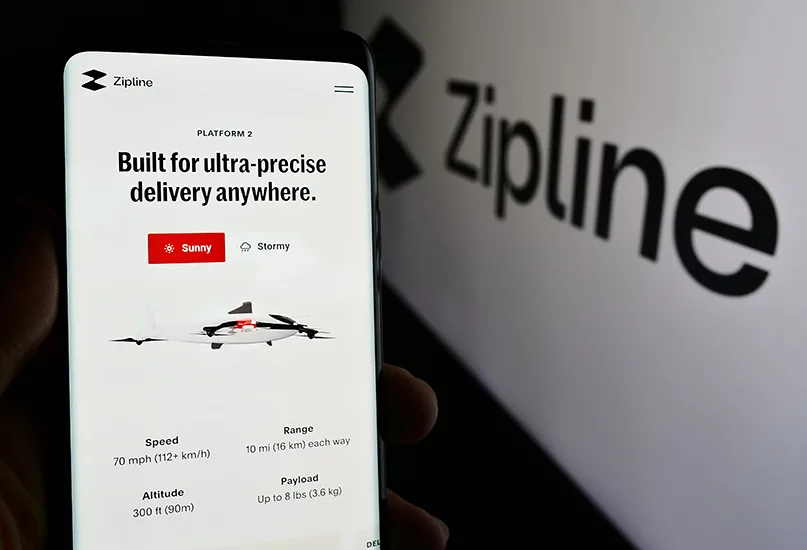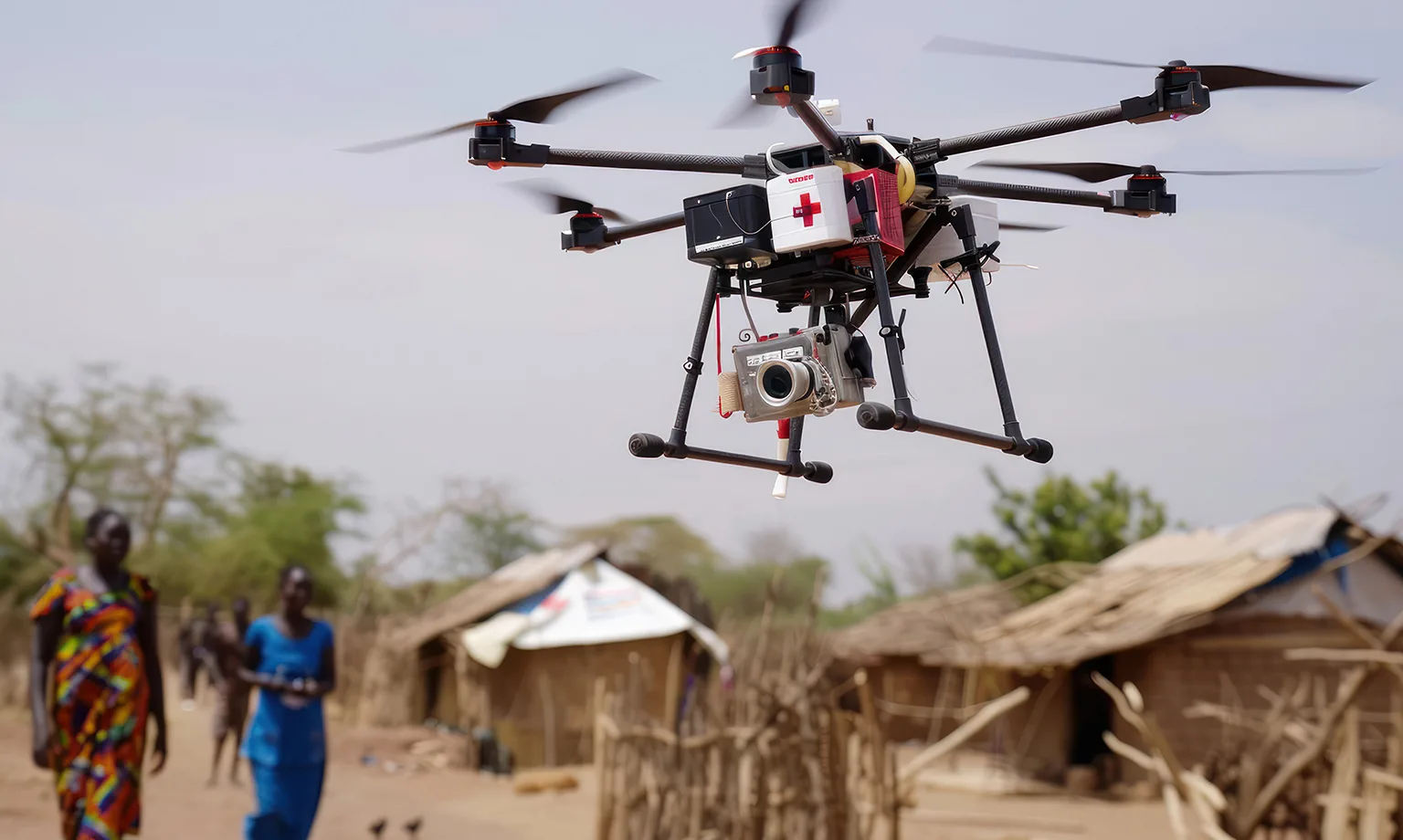The latest evolution in healthcare logistics, drone delivery is helping those most in need across Africa. We look at how the state-of-the-art technology dispenses vital medical supplies urgently and efficiently.
CRITICAL CARE BY AIR
Unmanned aerial vehicles (UAVs), commonly referred to as drones, are becoming an increasingly significant aid to public sectors, primarily utilised by some of the world’s strongest militaries as a cutting-edge advantage in conflict and national security.
On the flip side, the use of non-military drones is also growing, as the technology is leveraged worldwide to transform the logistics of medical supplies across a range of challenging environments and populations in need.
In Africa, the use of drones extends to hospitals and medical outreach clinics that are battling insurmountable pressures from growing levels of disease, rural areas in sub-Saharan Africa with limited transport networks, and other regions that have been affected by conflict or natural disasters in desperate need of humanitarian aid.
Regarding the latter, the benefits of this advanced technology are far-reaching and felt deeply across the continent.
Indeed, a drone’s ability to provide last-mile delivery of vital equipment and medication to hard-to-reach areas is an integral part of humanitarian aid.
SPEEDY MEDICAL SUPPLIES
Drones are increasingly being deployed by government bodies and humanitarian networks, such as UNICEF and the International Committee of the Red Cross (ICRC), for medical air operations due to their improved technological characteristics that enable them to deliver medical supplies in access-constrained environments.
Namely, drones can travel and transport medical supplies in minimal time, making the technology a vital link in the medical supply chain.
Their airborne function also means that they are not deterred by the inadequate infrastructure often seen across Africa’s most rural areas. This may include limited road or rail networks, which can result in excess time and effort when transporting critical medication and equipment.
As such, drone technology is advantageous in areas such as remote islands, unreachable mountain paths, or regions affected by natural disaster and conflict.
Additionally, drones are more cost-effective in comparison to other forms of airborne transport, such as helicopters. Although the delivery capacity of drones is only a few kilogrammes, their adaptability to different environments and high speeds make them a viable alternative.
On top of this, the GPS and mapping technology fitted to drones can be used to map the spread of infectious disease across a vast area and therefore have a more targeted understanding of where deliveries must be dropped.
Moreover, the complex environments where drones are typically required necessitate highly specialised parts and purpose-built elements that are often unavailable across Africa and must be exported from abroad.
Therefore, healthcare and humanitarian aid organisations must ensure that the required technology and spare parts are readily available before a drone takes flight.
To this end, companies need to also have a robust training and education programme in place to ensure maintenance and repairs are conducted quickly and efficiently by skilled individuals.
On top of this, a drone’s ability to be remote-controlled means that medical supplies can be safely delivered without having to involve any direct human contact, thus keeping people out of harm’s way in potentially dangerous situations.
Drone technology can likewise provide additional efficiencies to existing medical logistics services by quickly and efficiently responding to supply chain restrictions and any delivery challenges faced when providing aid.

GHANA DRONE DELIVERY SERVICE
Launched in 2019, the Ghana Drone Delivery Service has become one of the world’s largest drone logistics providers. The initiative was created through the collaborative work of the Ghana Health Service and Zipline, a US-based organisation that manufactures and distributes drones.
Zipline has established numerous distribution centres across the country and played a critical role in the delivery of medical supplies using 3PL drone technology. The service delivers urgent medicines, vaccines, equipment, and more from distribution sites in Omenako, Mpanya, Vobsi, Sefwi Wiawso, Kete Krachi, and Anum, making it one of the largest distribution networks in the world.
Ultimately, the Ghana Drone Delivery Service ensures that medical supplies reach rural areas of the country with limited transport infrastructure, making the initiative critically important.
UNPARALLED LOGISTICS ADVANTAGES
Currently, government and humanitarian agencies across Africa provide logistics and supply chain support via two modes of drone delivery: reverse logistics and forward logistics.
The latter uses fixed-wing drones to drop deliveries to the required recipient rather than landing on-site at a health facility, for instance.
This form of delivery means that materials are typically delivered from a central distribution facility to the required area using a hub-and-spoke transport network model. As such, forward logistics requires specialist infrastructure such as warehousing, fulfilment centres, and launch and retrieval systems for successful delivery.
Reverse logistics, meanwhile, utilises vertical take-off and landing (VTOL) aircraft that deliver goods in both hub-and-spoke and point-to-point transport network models.
Unlike forward logistics, this mode of delivery provides organisations with more logistical flexibility as the drone is able to land and take off at each location.
Thus, reverse logistics is less dependent on existing on-site infrastructure and therefore offers more advanced services.
Moving on to the logistical delivery of goods, there are two primary forms of drone-as-a-service (DaaS) used in medical logistics.
On one hand, the third-party logistics (3PL) model offers end-to-end logistics services across the entire supply chain. Indeed, 3PL service providers oversee procurement, warehousing, central order management, inventory storage, contract management, and IT solutions, alongside its main purpose of transportation.
This centralised approach means that healthcare and humanitarian organisations can outsource equipment where needed.
Currently, healthcare entities across Ghana and Rwanda are making the most of the comprehensive 3PL model.
More from Africa Outlook
On the other hand, carrier logistics models, currently used in Malawi and the Democratic Republic of the Congo (DRC), involve the point-to-point delivery of goods.
This model offers more flexibility when incorporated into existing supply chains as it is not dependent on specialised infrastructure, requires less corporate investment, and has minimal set-up costs.
As such, the delivery of medical services via drone is growing in prevalence across Africa’s medical supply chain, offering critical last-mile delivery and supporting underserved, remote, and access-constrained areas across the continent.
































